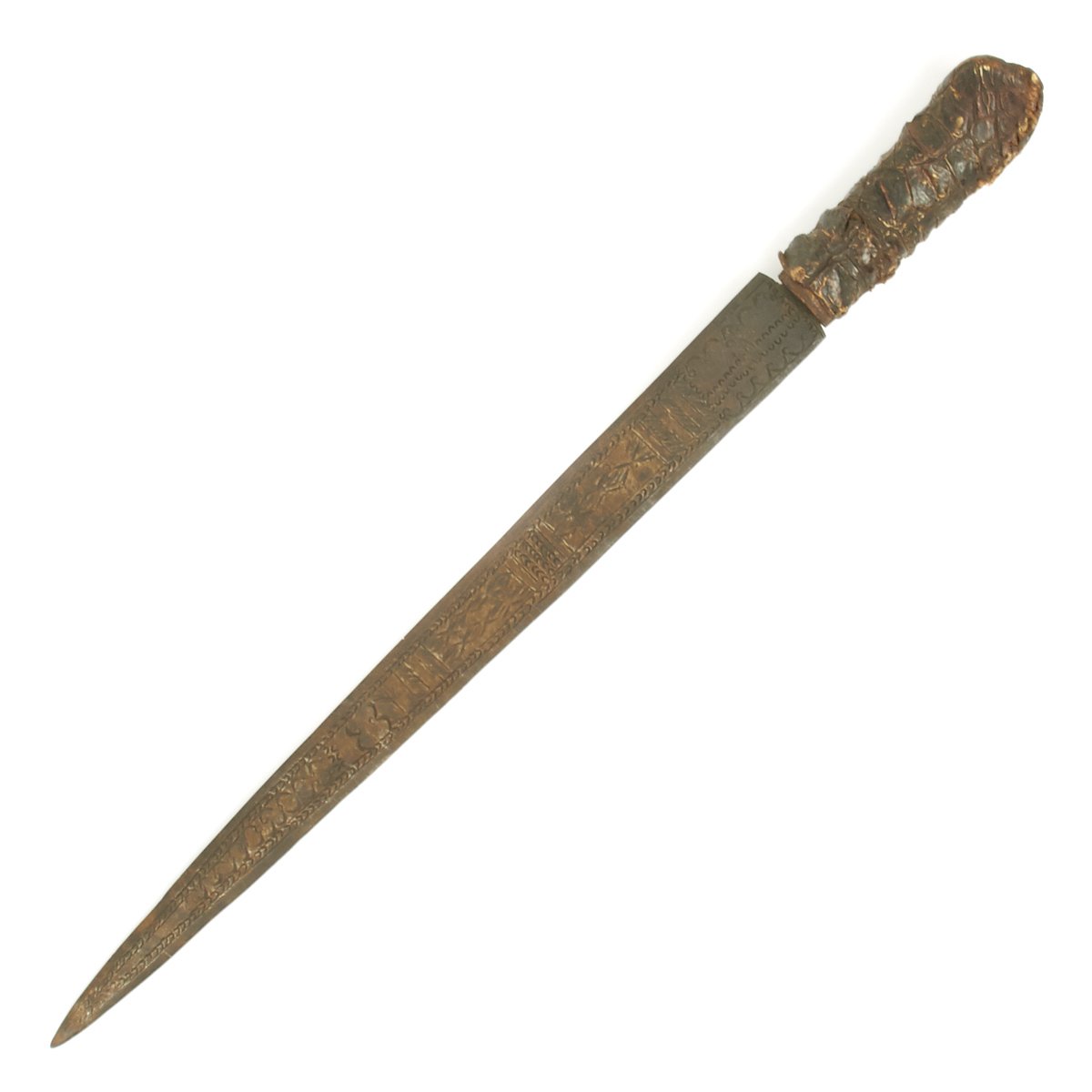Original 1880s Sudanese Mahdi Dervish Long Dagger with Crocodile Skin Grip Original Items
$ 295,00 $ 118,00
Original item. Only One Available. This came home with a British Soldier after the great Battle of Omdurman in 1898, when Great Britain finally annihilated the extreme Muslim sect initially led by the “Mardi” (the Chosen One) and then after his death the “Kalifa” ( the Successor).
The loss of General Gordon At Khartoum in 1875 sent an terrible message to the British Government led by Mr. Gladstone. Revenge was a number one priority however it took until 1898 before retribution was finally delivered mostly due to, believe it or not, “POLITICS”. The same held true for Britain after defeat by the Zulus at Isandwanna in 1879, but then the shock was sufficient for instant response resulting in the routing of the Zulu Nation within nine months
This is rather unusual, traditionally the Dervishes carried large Crusader like Broad Sword known as “KASKARAS” and small daggers bound to the left fore arm with which the held a Rhino hide shield. This unusual weapon is classic in Dervish style but the blade which has typical Dervish line engravings overall has a blade measuring a full 17″. The hilt/grip is of Ottoman style and completely covered in Crocodile skin, the real giveaway to its Nile origin. Having sat on exhibition for over one hundred years in a Regimental museum this Dervish long dagger or even short sword is now a total sleeper and if desired could use a very good cleaning. However it has taken 120 years to accumulate this “attic” patina that maybe a Collector would rather have it the way it now is.
Most unusual and attractive, ready to display.
Muhammad Ahmad bin Abd Allah (Arabic: محمد أحمد ابن عبد الله; August 12, 1844 – June 22, 1885) was a religious leader of the Samaniyya order in Sudan who, on June 29, 1881, proclaimed himself the Mahdi (or Madhi), the messianic redeemer of the Islamic faith. His proclamation came during a period of widespread resentment among the Sudanese population of the oppressive policies of the Turco-Egyptian rulers, and capitalized on the messianic beliefs popular among the various Sudanese religious sects of the time. More broadly, the Mahdiyya, as Muhammad Ahmad’s movement was called, was influenced by earlier Mahdist movements in West Africa, as well as Wahabism and other puritanical forms of Islamic revivalism that developed in reaction to the growing military and economic dominance of the European powers throughout the 19th century.
From his announcement of the Mahdiyya in June 1881 until the fall of Khartoum in January 1885, Muhammad Ahmad led a successful military campaign against the Turco-Egyptian government of the Sudan (known as the Turkiyah). During this period, many of the theological and political doctrines of the Mahdiyya were established and promulgated among the growing ranks of the Mahdi’s supporters, the Ansars. After Muhammad Ahmad’s unexpected death on 22 June 1885, a mere six months after the conquest of Khartoum, his chief deputy, Abdallahi ibn Muhammad took over the administration of the nascent Mahdist state.
Fast Shipping with Professional Packaging
Thanks to our longstanding association with UPS FedEx DHL, and other major international carriers, we are able to provide a range of shipping options. Our warehouse staff is expertly trained and will wrap your products according to our exact and precise specifications. Prior to shipping, your goods will be thoroughly examined and securely secured. We ship to thousands clients each day across multiple countries. This shows how we're dedicated to be the largest retailer on the internet. Warehouses and distribution centres can be located throughout Europe as well as the USA.
Note: Orders with more than one item will be assigned a processing date depending on the item.
Before shipping before shipping, we'll conduct a thorough inspection of the items you have ordered. Today, the majority of orders will be delivered within 48 hours. The delivery time will be between 3-7 days.
Returns
The stock is dynamic and we cannot completely manage it because multiple stakeholders are involved, including our factory and warehouse. So the actual stock may alter at any time. It's possible that you may not receive your order once the order has been made.
Our policy is valid for a period of 30 days. If you don't receive the product within 30 days, we are not able to issue a refund or an exchange.
You can only return an item if it is unused and in the same state as the day you received it. You must have the item in its original packaging.
Related products
Uncategorized
Armoured Fighting Vehicles of the World: AFVs of World War One (Hardcover Book) New Made Items
Uncategorized
Uncategorized
Uncategorized
Uncategorized
Uncategorized
Uncategorized
Uncategorized
Uncategorized
Uncategorized
Uncategorized
Uncategorized
Uncategorized
Uncategorized
Uncategorized
Uncategorized
Uncategorized
Uncategorized
Uncategorized












































































